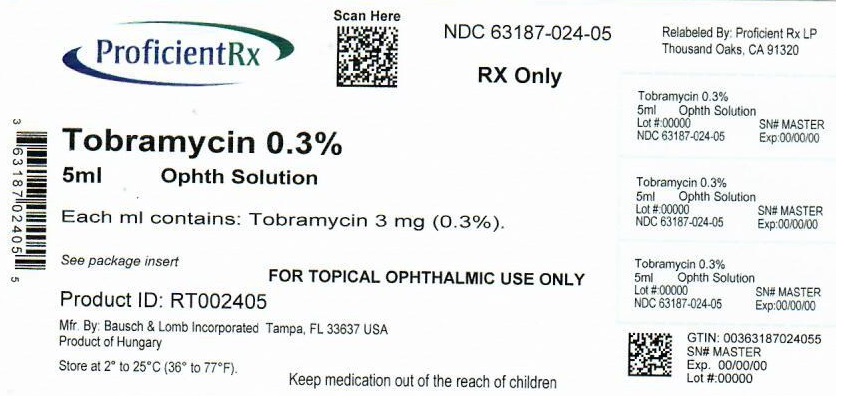Tobramycin Dailymed
Generic: tobramycin is used for the treatment of Bone Diseases, Infectious Central Nervous System Infections Pseudomonas Infections Respiratory Tract Infections Skin Diseases, Infectious Staphylococcal Infections Urinary Tract Infections Eye Infections, Bacterial Sepsis Intraabdominal Infections
Go PRO for all pill images
Rx only
Description:
Tobramycin ophthalmic solution is a sterile topical ophthalmic antibiotic formulation prepared specifically for topical therapy of external infections.
EACH mL CONTAINS:
ACTIVE: Tobramycin 3 mg (0.3%). INACTIVES: Boric Acid, Sodium Sulfate, Sodium Chloride, Tyloxapol and Purified Water. Sodium Hydroxide and/or Sulfuric Acid may be added to adjust pH (7.0 - 8.0).
PRESERVATIVE ADDED: Benzalkonium Chloride 0.1 mg (0.01%).
The structural formula of tobramycin is

Molecular formula: C18H37N5O9 Molecular weight: 467.52
Chemical name:
O-[3-amino-3-deoxy—α-D-gluco-pyranosyl-(1 → 4)]-O-[2,6-diamino-2,3,6-trideoxy-α-D-ribohexo-pyranosyl- (1 → 6)]-2-deoxystreptamine.
Tobramycin is a water-soluble aminoglycoside antibiotic active against a wide variety of gram-negative and gram-positive ophthalmic pathogens.
Clinical Pharmacology:
In Vitro Data: In vitro studies have demonstrated tobramycin is active against susceptible strains of the following microorganisms:
Staphylococci, including S. aureus and S. epidermidis (coagulase-positive and coagulase-negative), including penicillin-resistant strains.
Streptococci, including some of the Group A-betahemolytic species, some nonhemolytic species, and some Streptococcus pneumoniae.
Pseudomonas aeruginosa, Escherichia coli, Klebsiella pneumoniae, Enterobacter aerogenes, Proteus mirabilis, Morganella morganii, most Proteus vulgaris strains, Haemophilus influenzae and H. aegyptius, Moraxella lacunata, and Acinetobacter calcoaceticus and some Neisseria species. Bacterial susceptibility studies demonstrate that in some cases, microorganisms resistant to gentamicin retain susceptibility to tobramycin. A significant bacterial population resistant to tobramycin has not yet emerged; however, bacterial resistance may develop upon prolonged use.
Indications And Usage:
Tobramycin Ophthalmic Solution is a topical antibiotic indicated in the treatment of external infections of the eye and its adnexa caused by susceptible bacteria. Appropriate monitoring of bacterial response to topical antibiotic therapy should accompany the use of Tobramycin Ophthalmic Solution. Clinical studies have shown tobramycin to be safe and effective for use in children.
Contraindications:
Tobramycin Ophthalmic Solution is contraindicated in patients with known hypersensitivity to any of its components.
Warnings:
NOT FOR INJECTION INTO THE EYE. Sensitivity to topically applied aminoglycosides may occur in some patients. If a sensitivity reaction to Tobramycin Ophthalmic Solution occurs, discontinue use.
Precautions:
General:
As with other antibiotic preparations, prolonged use may result in overgrowth of nonsusceptible organisms, including fungi. If superinfection occurs, appropriate therapy should be initiated.
Information for patients:
Do not touch dropper tip to any surface, as this may contaminate the contents.
Pregnancy Category B.
Reproduction studies in three types of animals at doses up to thirty-three times the normal human systemic dose have revealed no evidence of impaired fertility or harm to the fetus due to tobramycin. There are, however, no adequate and well-controlled studies in pregnant women. Because animal studies are not always predictive of human response, this drug should be used during pregnancy only if clearly needed.
Nursing Mothers:
Because of the potential for adverse reactions in nursing infants from Tobramycin Ophthalmic Solution, a decision should be made whether to discontinue nursing the infant or discontinue the drug, taking into account the importance of the drug to the mother.
Adverse Reactions:
The most frequent adverse reactions to tobramycin ophthalmic solution is localized ocular toxicity and hypersensitivity, including lid itching and swelling, and conjunctival erythema. These reactions occur in less than three of 100 patients treated with tobramycin. Similar reactions may occur with the topical use of other aminoglycoside antibiotics. Other adverse reactions have not been reported from tobramycin therapy; however, if topical ocular tobramycin is administered concomitantly with systemic aminoglycoside antibiotics, care should be taken to monitor the total serum concentration.
Overdosage:
Clinically apparent signs and symptoms of an overdose of tobramycin ophthalmic solution (punctate keratitis, erythema, increased lacrimation, edema and lid itching) may be similar to adverse reaction effects seen in some patients.
Dosage And Administration:
In mild to moderate disease, instill one or two drops into the affected eye(s) every four hours. In severe infections, instill two drops into the eye(s) hourly until improvement, following which treatment should be reduced prior to discontinuation.
DO NOT USE IF IMPRINTED NECKBAND IS NOT INTACT.
FOR OPHTHALMIC USE ONLY
How Supplied:
Tobramycin Ophthalmic Solution USP, 0.3% is supplied in a plastic bottle with a controlled drop tip in the following size:
5 mL bottle – NDC 63187-024-05
Storage:
Store at 2°-25°C (36°-77°F). Avoid excessive heat.
KEEP OUT OF REACH OF CHILDREN.
Revised August 2007
Bausch & Lomb Incorporated Tampa, FL 33637©Bausch & Lomb Incorporated
9116801 (Folded) 9116901 (Flat)
Repackaged by: Proficient Rx LP Thousand Oaks, CA 91320
Principal Display Panel
DISCLAIMER:
"This tool does not provide medical advice, and is for informational and educational purposes only, and is not a substitute for professional medical advice, treatment or diagnosis. Call your doctor to receive medical advice. If you think you may have a medical emergency, please dial 911."
"Do not rely on openFDA to make decisions regarding medical care. While we make every effort to ensure that data is accurate, you should assume all results are unvalidated. We may limit or otherwise restrict your access to the API in line with our Terms of Service."
"This product uses publicly available data from the U.S. National Library of Medicine (NLM), National Institutes of Health, Department of Health and Human Services; NLM is not responsible for the product and does not endorse or recommend this or any other product."
PillSync may earn a commission via links on our site


